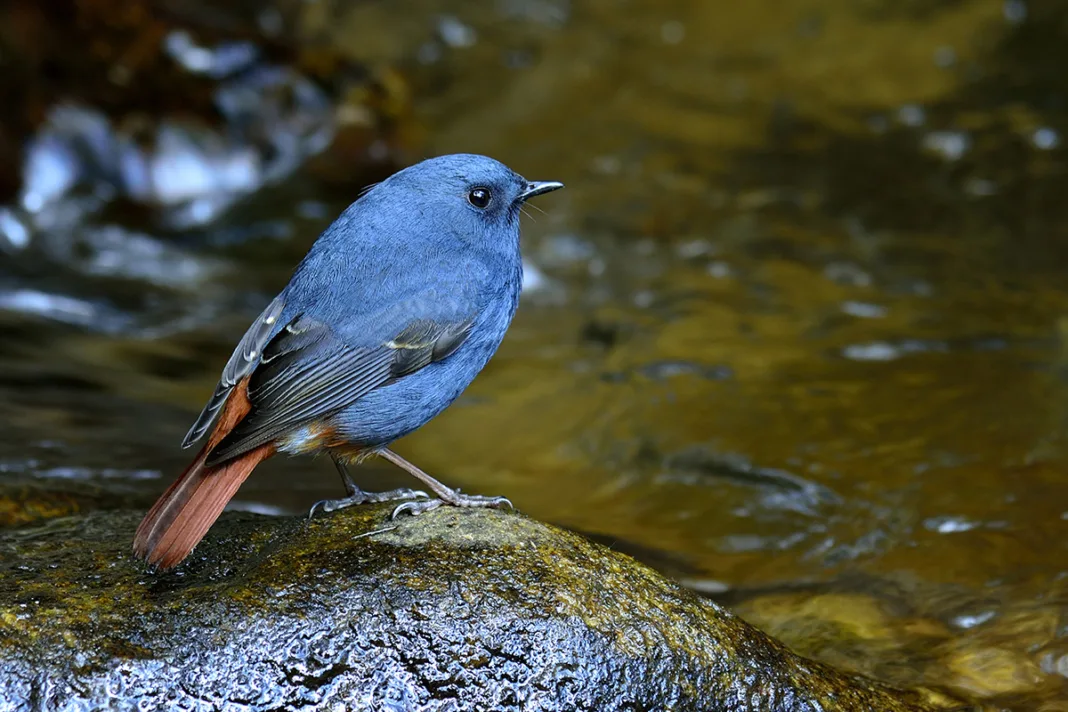Dutch birdman Sander Van Duuren gives an insight into one of his favourite species groups: the fabulous genus Phoenicurus.
The true redstarts are just a small part of the much larger family of Old World flycatchers: a genus, Phoenicurus, which currently consists of 14 species. Phoenicurus comes from two Greek words: Phoinix meaning crimson or red, and ouros meaning tailed. So the redstarts can be recognised by their orange-reddish tail, but the red is also frequently found in many other areas of the plumage. The odd one out is the male blue-capped redstart (P. coeruleocephala), which not only lacks the red tail but does not feature red anywhere. The female, however, does have an orange tail.
All species are relatively small-sized birds with Moussier’s redstart (P. moussieri) being the smallest and Güldenstädt’s redstart (P. erythrogastrus) the largest. While some species are frequently found in aviculture, some remain very rare – e.g. the white-throated redstart (P. schisticeps) – and difficult to keep. It’s mainly the true alpine species that can be difficult to get accustomed to “normal” European climate, with some species showing respiratory problems. But generally Phoenicurus redstarts are quite good aviary birds, which can be kept with various other species, and most have been bred.
Early memories
The first time I saw one of the “exotic” redstarts, I only had a brief view and just a blurry photo as evidence of my encounter. This photo is long lost but the memory remains. I’d contacted one of the bigger bird dealers in Holland for a chance to see some softbills. I went there primarily to see the “bumblebee bird”: black-throated bushtit (Aegithalos concinnus). After seeing his, we went for a quick walk around the aviaries.
The dealer mentioned that a pair of Eversmann’s redstarts (P. erythronotus) shared the aviary with a few other birds. I only remember seeing the female, but I was thrilled to see a different species outside the two European ones. Eversmann’s redstart can be recognised by its grey cap with black face mask. It features prominent white on the upper wing with an orange/reddish belly and tail. The female is uniform brown with only a reddish/orange tail. The breed in the mountains of Mongolia, Kazakhstan and China, primarily in rocky scrub, fields and coniferous forest edges.
It was quite a while before I saw another species of redstart. In 2014 I went for the first time to the show of the Dutch Softbill Society. On display was a plumbeous water redstart (formerly Rhyacornis fuliginosus, but now placed in Phoenicurus alongside the less-known P. bicolor). This south-east Asian species is a striking bird. The male is slaty blue with an orange-reddish tail. The female is greyish with a heavily barred breast and belly. It’s a species found on the margins of rocky streams and rivers, usually in mountain areas.
Out of Africa
The only species of redstart endemic to Africa is the Moussier’s, which hails from the Atlas mountains. Also a striking species, it has a prominent white eye-stripe that runs to its shoulders. When I visited Plzen Zoo in the Czech Republic there were two males on show. The birds had been confiscated by the authorities and given to the zoo. This species is very rare in zoos and Plzen was the first to keep this species in Europe. In private aviculture it is at least a bit better known. For the past few years a few have been on sale at the Zwolle Birdmarket and last year a nice male was on display at the Dutch National show.
The male has a black face with, as said, a prominent white eye-stripe and a large patch of white on the primary wing feathers. Throat, breast and belly are reddish/orange and the tail is reddish. The hen also features an orange belly with plain brown upperparts and a reddish tail. This is a bird of open rocky hill country and open scrubland up to 3,200m (10,500ft). It is found in Morocco and Tunisia.
Treasured rarities
In 2016 there was an advert on VogelMarkt for white-throated redstarts (P. schisticeps): perhaps the rarest of this genus in aviculture. I hoped to see them but lost track until, a few months later, I went to a breeder I had met at Zwolle. He was quite a good breeder of another species in the same family, the white-capped shama (Copsychus stricklandii), and asked me to come over and have a look at his birds. At once I recognised a pair of white-throated redstarts! Both sexes have a white throat, with the male sporting a stunning blue cap with darkish blue face mask and an orange breast. A bird of subalpine meadows and woods, the species is found in the Himalayas from Nepal to China.
The following year I was lucky enough to see another pair of these stunning birds when I visited a German breeder. Both of those breeders also kept another redstart species – for me the most beautiful species of redstart – the white-capped (P. leucocephalus). One of the largest Phoenicurus (and formerly placed in the genus Chaimarrornis), it’s still an uncommon bird in captivity, although almost every year a bird can be seen at Zwolle.
This species is the only redstart with sexes alike. It features a prominent white cap, black face, upper breast and wings, and dark red belly and tail parts. It can be found along larger mountain streams from Uzbekistan through the Himalayas to Myanmar.
Find more news and articles like this on the Cage & Aviary Birds website. Subscribe to Cage & Aviary Birds magazine now.


